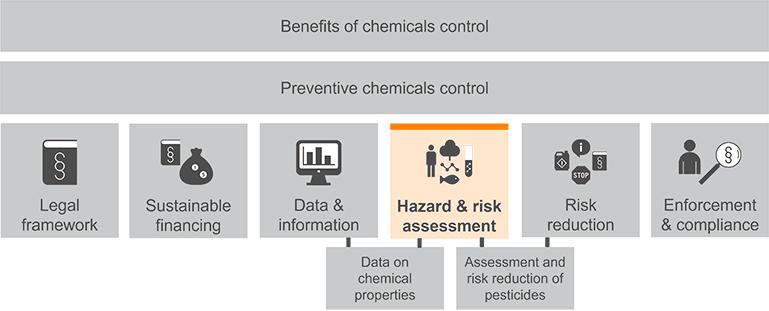Hazard and risk assessment of chemicals
Hazard and risk assessment of a chemical will determine its potential to cause adverse effects to human health and the environment. The purpose of such assessments is to serve as a technical background for introduction of risk reduction measures.
General information
It is important to distinguish between hazard and risk in the assessment of chemicals. While hazard refers to the intrinsic properties of a chemical, risk considers hazard in conjunction with exposure, the probability of an adverse outcome (harm). Exposure to a chemical means how and in which concentration a human or an organism get in contact with the chemical.
Hazard x Exposure = Risk
The basic steps in risk assessment of chemicals are:
- Hazard assessment
- Exposure assessment
- Risk characterization
Hazard assessment
The hazard of a chemical depends on its intrinsic properties, its capacity to interfere with normal biological processes in living organisms, or its capacity to burn, explode, corrode, etc. Hazard assessment is the identification of the nature (type) of adverse effects that a chemical substance or a mixture of chemicals substances has the inherent capacity to cause in an organism, system, or population. The hazard assessment also includes hazard characterisation, with a so called dose-response assessment, where the dose is related to the effects and the incidence of the effect in an exposed population.
Read more about hazard assessment in our Guidance on Hazard and Risk Assessment of Chemicals, chapter 3.
Read more about data on chemical properties.
Exposure assessment
Exposure assessment determines the nature and extent of exposure for humans and organisms in the environment to chemicals under different conditions. While hazardous properties are chemical specific and data on such properties can be used globally, exposure depends on conditions that may vary between countries or, more likely, at a local level. Such conditions could be working conditions, waste management and environmental factors such as climate.
In lack of local exposure data countries are advised to check available exposure assessments that have already been performed. Lack of detailed, quantitative exposure data should not prevent authorities from making an estimate of the risk to the environment or human health. As a first step, it might be sufficient to base the exposure estimation on information such as volume of the substance produced, imported or placed on the market, use pattern, monitoring studies etc.
Read more about exposure assessment in our Guidance on Hazard and Risk Assessment of Chemicals, chapter 4.
Risk characterisation
Risk characterisation combines the results of a hazard assessment (hazard identification and dose-response assessment) with an exposure assessment. Substance-specific toxicity information is compared against measured or estimated exposure levels to determine whether concentrations associated with an exposure are of concern and triggers risk reduction measures.
To conduct a risk assessment can cost a lot of money and resources and it is therefore important to start simple by using a generic approach and already available risk assessment information (for example from international agencies or authorities). Depending on resources and the local context a more refined assessment can be made.
Read more about risk characterisation in our Guidance on Hazard and Risk Assessment of Chemicals, chapter 7.3.
Assessment of pesticides
Pesticides have intrinsic properties aimed to have an effect on target organisms and they are deliberately spread to control various kind of pests. Thorough hazard and risk assessment of pesticides is important to reduce possible negative impact of pesticides on people's health and the environment.
Read more about hazard and risk assessment and risk reduction of pesticides.
Guidance on hazard and risk assessment of chemicals - an introduction
This guidance is an introduction to hazard assessment and risk assessment of chemicals. It presents key terms and concepts and explains the general approach.
The guidance covers the following areas:
- General concepts and principles of risk assessment
- Hazard assessment
- Exposure
- Risk characterisation
- An approach to risk assessment using available information
- Risk assessment in practice - the EU example
Read our guidance on Hazard and risk assessment of chemicals - an introduction.
This guidance complements the UNEP Guidance on the Development of Legal and Institutional Infrastructures and Measures for Recovering Costs of National Administration for Sound Management of Chemicals (LIRA Guidance).
Credits
Illustrations by Maja Modén.


